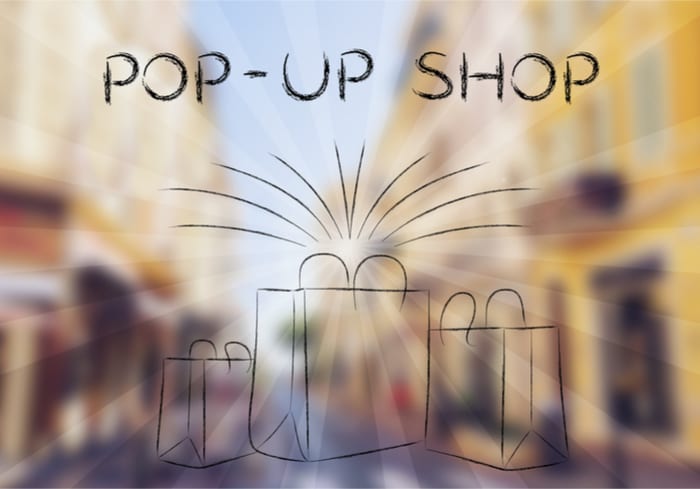
The best joy is often fleeting.
So go some views of philosophy, religion and psychology. We at PYMNTS don’t mean to burden you with such abstract concepts. But we want to take a few minutes to talk about pop-up shops, and how those temporary but often lucrative retail efforts are shaping commerce — and being shaped by payments — and what could be coming next.
The latest pop-up developments concern the Hollister apparel brand, which is owned by Abercrombie & Fitch. As PYMNTS readers likely know, Abercrombie & Fitch has been going through some store troubles lately, challenges not unknown other retailers in this age of rising eCommerce — in March, news emerged that the brand would close up to 40 stores by next February. Over the last eight years, the retailer has shuttered about 475 stores, and has also reduced the size of its stores and remodeled existing locations. Even so, the company has certainly not given up on physical retail. Abercrombie & Fitch has said it plans to invest approximately $120 million in store experiences in 2019, including 85 new stores experiences and 40 new stores.
Riding Retail Trends
One way to make better connections with shoppers in person is via pop-up stores.
According to a new report from CNBC, the company — apparently encouraged by the relatively good health of its Gilly Hicks line of lingerie, itself part of Hollister — its striving to increase sales via those temporary retail locations. On Monday (July 22), in fact, Abercrombie said that “it opened four new pop-up shops last week, at Tysons Corner Center in Virginia, Dolphin Mall in Miami, Los Cerritos Center in California and at Baybrook Mall in Friendswood, Texas,” according to the report. “All are expected to be open for about 12 months, according to the company. And these stores join two already existing Gilly Hicks shops at Ala Moana Center in Honolulu and Roosevelt Field mall in East Garden City, New York.”
Pop-up retail stores command a good deal of attention and even excitement in retail, and for good, perhaps even obvious reason: Physical shopping, especially at malls, is on the decline as consumers become ever more mobile, and ever more sophisticated about using multiple channels to find products and complete services. Pop-ups can offer relatively low costs for retailers and a severely reduced commitment when it comes to securing physical space. That allows for the quicker exploitation of retail trends — as shown by the Abercrombie move — and the introduction of relatively experimental products, brands and lines without the risks that can come with full bore brick-and-mortar efforts.
Pop-Up Costs
Costs for pop-up shops can vary widely, of course. But one recent and reliable estimate said “you also can pull off a short-term pop-up for as little as $1,500.” Another analysis, this one from Popertee, found that “the total cost of one 30-day pop-up” stood at about $33,000.
The pop-up proposition is attractive not only to retailers with a long focus on physical stores. Those temporary stores also provide a way for eCommerce operators to connect with more customers in the physical real and further their own brick-and-mortar plans.
Amazon, as you can imagine, provides a good example of that — and a good example of why the pop-up trend is still and hit-and-miss type of thing. That’s because earlier this year, the retailer said it would shutter all 87 of its pop-up stores in the United States by the end of April. The move ended the proliferation of the small shops in malls, Kohl’s stores and Whole Foods in 21 states. The stores were only about a few hundred square feet and have devices like Alexa-enabled speakers and Kindles. The pop-up stores were mostly used to show off items like Alexa devices and to let customers trade in old tablets for credit.
Amazon provided no real details about the reasons behind the move. Amazon reportedly told landlords that the move wasn’t one meant to retreat from retail locations.
“The pop-up stores were designed to ascertain demand, and Amazon can leverage that data for prototypes of other stores,” said Charles Lanier, a landlord. He added that Amazon is always innovating and that at his company, “We’re big fans of the brand.”
A few months later, however, Amazon said it planned to launch pop-up stores in the U.K. to give small businesses the chance to sell on High Street. In a press release, Amazon said it teamed up with Enterprise Nation, which supports more than 90,000 U.K. small businesses, to launch Clicks and Mortar, a new program that helps small businesses grow in-store and online.
The program will enable more than 100 small online business to sell on High Street in 10 Clicks and Mortar shops across the U.K. Amazon is running a year-long pilot program aimed at helping up-and-coming online brands grow their presence in the physical world. The results of the pilot will be measured by independent researchers and submitted to the government to gauge how successful it is.
Pop-ups also are riding a wave of growth when it comes to food, either via restaurants or small, even individual operators eager to get their dishes before more consumers in various, sometimes non-traditional settings. Part of that trend — as documented by PYMNTS — is tied to the ongoing deployment of mobile payment solutions, which enables those smaller businesses to sell to consumers who don’t have (or don’t want to pay with) cash.
The world of pop-up shops is one of those places where seemingly anything can happen — and where some of newest retail best practices might even emerge over time, given all the interest in those temporary locations.